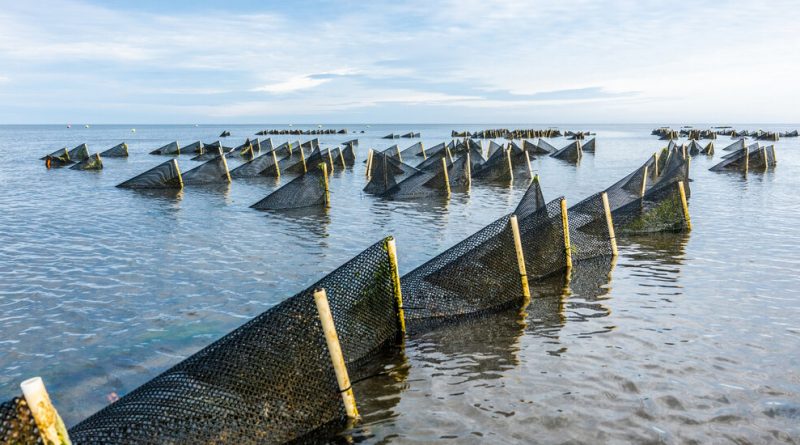On the Shores of Cape Cod, Where the Oyster Is Their World
[ad_1]
At the onset of the coronavirus pandemic, with travel restrictions in place worldwide, we launched a series — The World Through a Lens — in which photojournalists help transport you, virtually, to some of our planet’s most beautiful and intriguing places. This week, Randy Harris shares a collection of images from the shores of Cape Cod.
When I first met Chris Crobar, he was a half mile from the shore, on the tidal flats that stretch far out into Cape Cod Bay. It was 5 a.m., and I was out for a walk at low tide. From a distance, I saw what looked like little black sails in the water.
Chris was a spectacle: alone with his boat and table in the middle of the bay — like an artist with his easel, painting a fiery sunrise. He stood there fastidiously scraping the barnacles off his oysters, then tossing them back into the cages where they’ll sit for a couple of years on the floor of the bay.
Before the arrival of the Europeans, the native people of Cape Cod, the Nauset tribe, had an abundant supply of oysters. Crassostrea virginica, known as the American oyster (or the eastern, Wellfleet, Atlantic or Virginia oyster), was naturally flush in coastal areas and estuaries, where the rivers meet the sea. Oyster reefs were America’s coral reefs; oysters filtered the water — some adult oysters can filter 50 gallons a day — and fed a range of other sea life.
In the 18th and 19th centuries, disease, overharvesting and new technologies — including developments in dredging, canning and transportation — transformed America’s oyster industry. The native oyster population in Wellfleet, Mass., for example, was nearly depleted. To cope, locals began seeding the waters with young oysters imported from the Chesapeake.
Modern-day aquaculture has changed the game. A company called Aquacultural Research Corporation, founded around 1960, produces shellfish seed — tiny juvenile oysters, also called “spat” — and sells it to local shellfish farmers. Chris Crobar is one of those farmers. A native of Eastham, Mass., he grew up working on his father’s clam boat. Today, he sets his hours not by the clock, but by the tide. He has been raising oysters for five years on his two-acre farm in the Cape Cod Bay — just beyond First Encounter Beach, the location of the first meeting between the Nauset people and the Pilgrims.
Cape Cod is as unique as its oysters. Depending on the location, the high tidal waters flush the oysters with a varying mix of freshwater and saltwater. This helps create nuanced flavors.
Wellfleet, which juts farther out into the bay, is famous throughout the world for its briny oyster. In Barnstable, Chatham and Orleans, the fresh tidal water and sweet marsh algae combine to create a sweet and earthy flavor profile. Eastham oysters are known for being both mildly briny and earthy.
Paul Wittenstein, the general manager of A.R.C., explained how the hatchery produces its seed: In midwinter, the hatchery places adult shellfish in warm water that’s rich with algae, which causes the shellfish to spawn. The hatchery then catches the eggs, hatches them and grows them in their tanks until spring, when they’re moved into the A.R.C.’s nursery system. From there, they continue to grow before being measured, counted and sold to farmers.
After obtaining his oyster seeds from A.R.C., Chris initially grows them in mesh bags, using the French rack-and-bag system. Later, the oysters are transferred into metal grow-out cages, where they sit on the bottom of the bay from one-and-a-half to two years — until they reach 2.5 to 3 inches, to be marketed as “petite” or “cocktail” oysters, or 3 inches or more to be marketed as “select” oysters. (He also digs for wild razor clams and quahogs.)
Lately there has been a surge in aquaculture farming, especially with oysters. But yields can vary significantly from year to year. This past winter was mild, with little to no ice. Seed did well. Many farmers were expecting a good year. But with water temperatures increasing to over 80 degrees at high tide, both algae blooms and crashes can result, leaving the oysters with nothing to eat.
Oyster farming, in other words, has always been an unpredictable business. And the coronavirus pandemic has hit the industry hard: With fewer people dining out, farmers are sitting on their inventory. Some have feared a collapse of the market.
But Chris is more hopeful. “It’s important to me to be optimistic about the future,” he said. “For now we have to keep planting and raising shellfish, hoping that things will eventually get back to normal.”
“Fishermen adapt,” he added, “and always find a way to keep moving forward.”
Randy Harris is a photographer based in New York. You can follow his work on Instagram.
